An Analysis of The Entropy Generation in a Square Enclosure
Abstract
:Introduction
Mathematical Formulation



















Numerical Solution
Results And Discussion
Conclusion
Nomenclature
| g | gravitational acceleration, m/s2 | X, Y | dimensionless coordinates |
| H | enclosure height, m | x, y | coordinates, m |
| k | thermal conductivity, W/mK | ||
| L | enclosure width, m | Greek Letters | |
| Ih | heated part, m | α | thermal diffusivity, m2/s |
| Ns | dimensionless entropy generation number | β | coefficient of thermal expansion, 1/K |
| P | dimensionless pressure | ρ | density, kg/m3 |
| p | pressure, N/m2 | θ | dimensionless temperature |
| Pr | Prandtl number | ν | kinematic viscosity, m2/s |
| entropy generation, W/m3 -K | ζ | dimensionless vorticity | |
| Q | overall heat transfer rate, W | ψ | stream function, m2/s |
| q | heat flux, W/m2 | Ψ | dimensionless stream function |
| Ra | Rayleigh number | τ | dimensionless time |
| T | temperature, K | Φ | viscous dissipation function, s-2 |
| t | time, s | ω | vorticity, s-1 |
| Tavg | average temperature ( =(Th+Tc)/2 ), K | μ | dynamic viscosity, N-s/m2 |
| ΔT | temperature difference, K | φ | irreversibility distribution function |
| U | dimensionless horizontal velocity component | ||
| u | horizontal velocity component, m/s | Subscripts | |
| V | dimensionless vertical velocity component | c | cold surface |
| v | vertical velocity component, m/s | h | hot surface |
References
- Catton, I. Natural Convection in Enclosures. Proc. the 6th Int. Heat Transfer Conference 1978, Vol.6, 13–31. [Google Scholar]
- Yang, K.T. Convective Heat Transfer; Kakaç, S., Shah, R.K., Aung, W., Eds.; Handbook of Single – Phase Convective Heat Transfer, John Wiley; 1987; Chapter 13. [Google Scholar]
- Ostrach, S. Natural Convection in Enclosures. J. Heat Transfer 1988, 110, 1175–1190. [Google Scholar] [CrossRef]
- Kakaç, S.; Yener, Y. Convective Heat TransferCRC Press, 2nd ed.; (ISBN 0-8493-9939-4); 1995; pp. 340–350. [Google Scholar]
- Bejan, A. Convective Heat TransferJohn Wiley & Sons. Inc., 2nd ed.; (ISBN 0-471- 57972-6); 1995; Chapter 5; pp. 219–267. [Google Scholar]
- Poilikakos, D. Natural convection in a confined fluid - filled space driven by a single vertical wall with warm and cold regions. J. of Heat Transfer 1985, 107, 867–876. [Google Scholar] [CrossRef]
- Angirasa, D.; Pourquié, M. J. B. M.; Nieuwstadt, F. T. M. Numerical study of transient and steady laminar buoyancy - driven flows and heat transfer in a square open cavity. Numerical Heat Transfer Part A 1992, 22, 223–239. [Google Scholar] [CrossRef]
- Ayhan, O.; Ünal, A.; Ayhan, T. Numerical solutions for buoyancy - driven flow in a 2-D square enclosure heated from one side and cooled from above. Davis, G. V., Leonardi, E., Eds.; In Advanced in Computational Heat Transfer; TR; 1997; pp. 337–394. [Google Scholar]
- Küblbeck, K.; Merker, G. P.; Straub, J. Advance numerical computation of two - dimensional time - dependent free convection in cavities. Int. J. Heat Mass Transfer 1980, 23, 203–217. [Google Scholar] [CrossRef]
- Markatos, N. C.; Pericleous, K. A. Laminer and turbulent natural convection in an enclosed cavity. Int. J. Heat Mass Transfer 1984, 27, 755–772. [Google Scholar]
- Lage, L.; Bejan, A. The Ra-Pr domain of laminar natural convection in an enclosure heated from the side. Numerical Heat Transfer Part A 1991, 19, 21–41. [Google Scholar] [CrossRef]
- Yücel, N.; Türkoğlu, H. Natural convection in rectangular enclosures with partial heating and cooling. Warme- und Stuffübertragung 1994, 29, 471–478. [Google Scholar] [CrossRef]
- Türkoğlu, H.; Yücel, N. The effect of heater and cooler locations on natural convection in square cavities. Numerical Heat Transfer Part A 1995, 27, 351–358. [Google Scholar] [CrossRef]
- Bejan, A. Second law analysis in heat transfer. Energy - The Int. J. 1980, 5, 721–732. [Google Scholar] [CrossRef]
- Bejan, A. Entropy Generation Minimization; CRC Press: USA, 1996; Chapter 4; pp. 71–109. [Google Scholar]
- Bejan, A. Entropy Generation Through Heat and Fluid Flow; John Wiley & Sons. Inc.: Canada, 1994; Chapter 5; p. 98. [Google Scholar]
- San, J.Y.; Worek, W.M.; Lavan, Z. Entropy generation in combined heat and mass transfer. Int. J. Heat Mass Transfer 1987, 30(7), 1359–1369. [Google Scholar] [CrossRef]
- Krane, R. J. A Second law analysis of the optimum design and operation of thermal energy storage systems. Int. J. Heat Mass Transfer 1987, 30, 43–57. [Google Scholar] [CrossRef]
- Arpacı, V. S. Radiative entropy production - lost heat into entropy. Int. J. Heat Mass Transfer 1993, 36, 4193–4197. [Google Scholar]
- Tsatsaronis, G. Design optimization of thermal systems using exergy - based techniques. Sciubba, E., Moran, M.J., Eds.; In Second Law Analysis: Towards the 21 st Century; Roma; 1995; pp. 183–191. [Google Scholar]
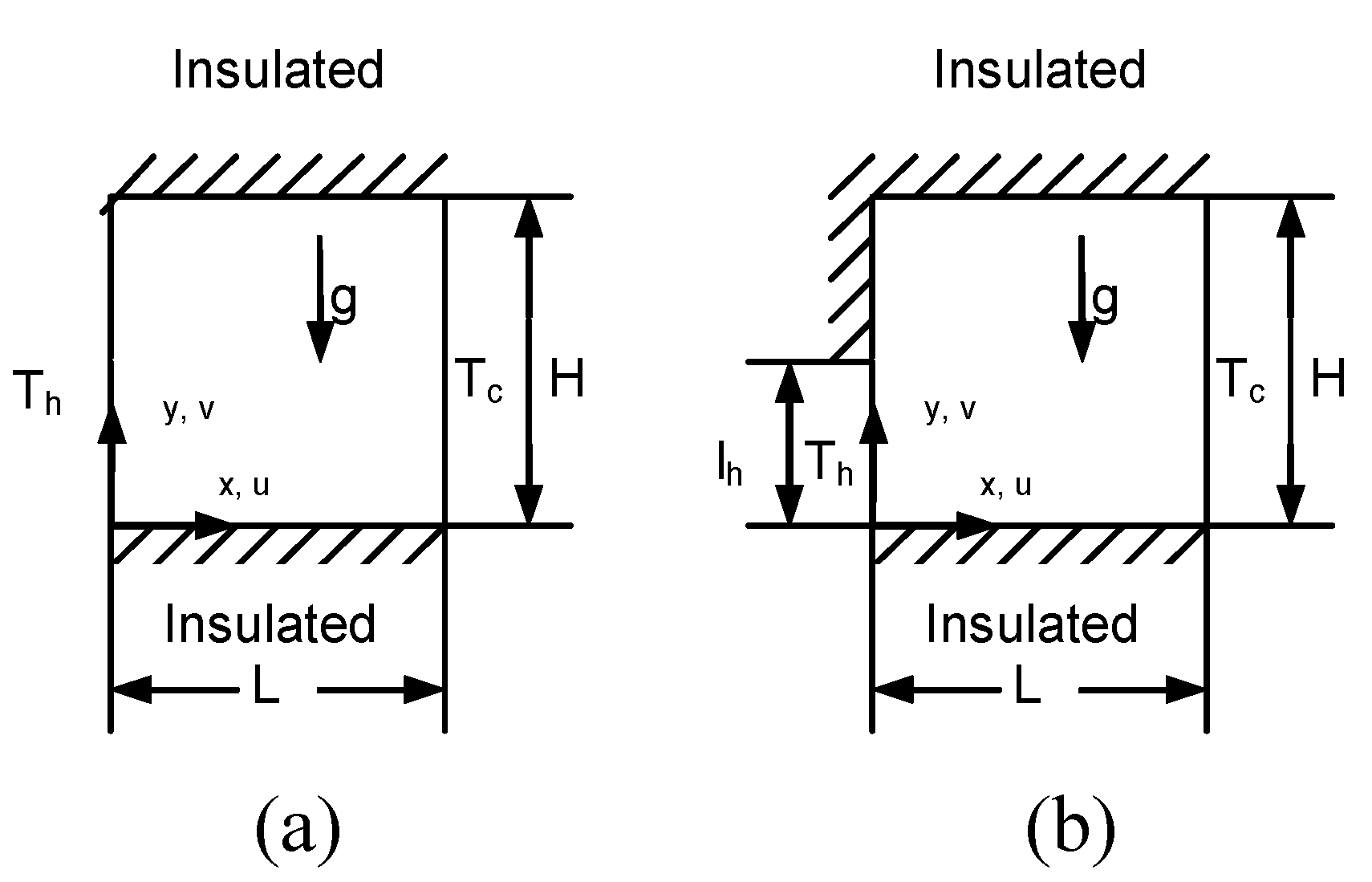
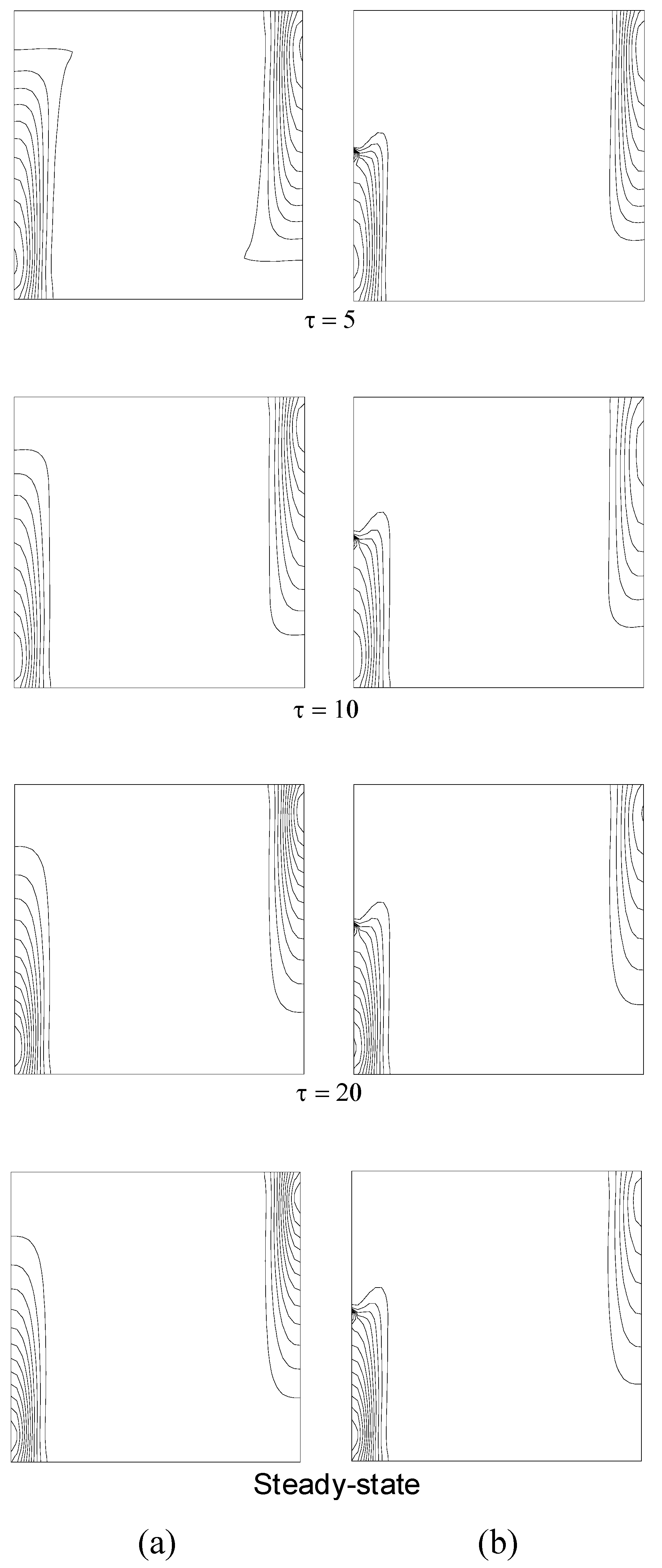
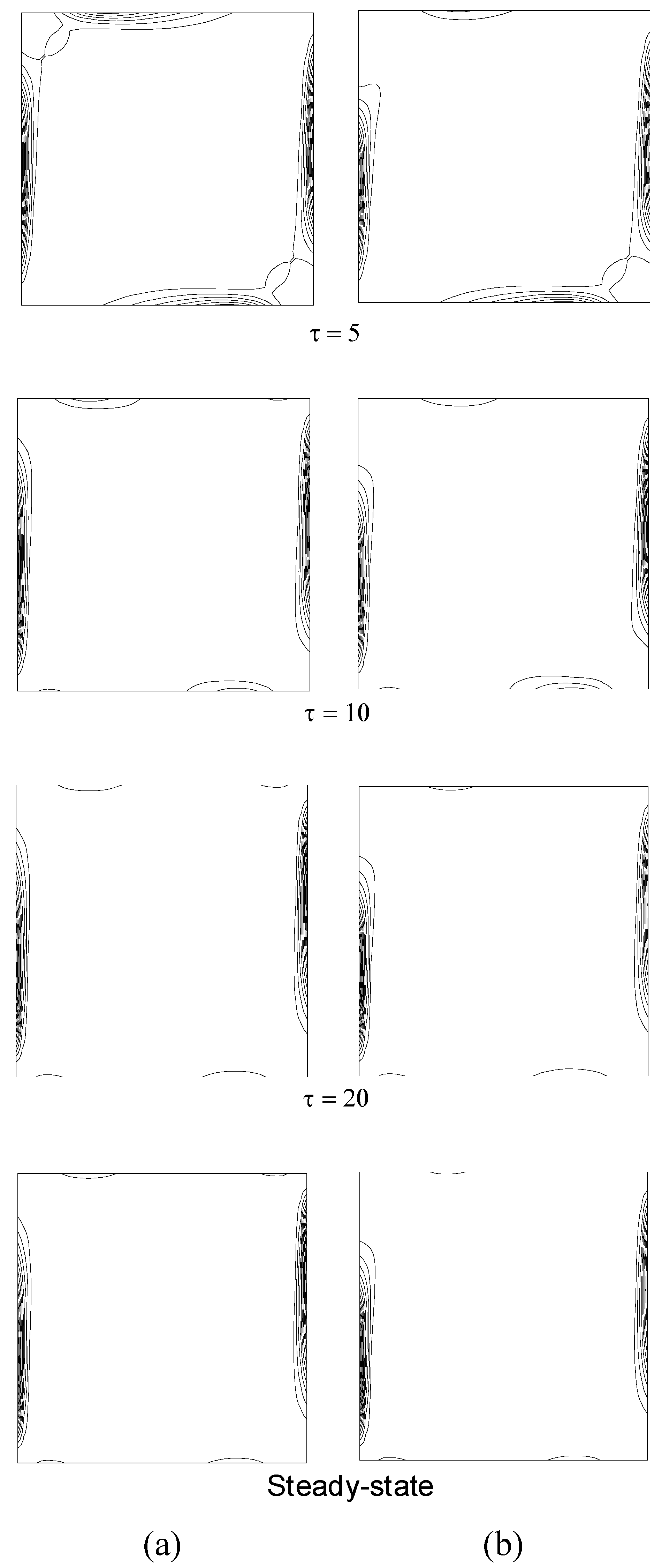
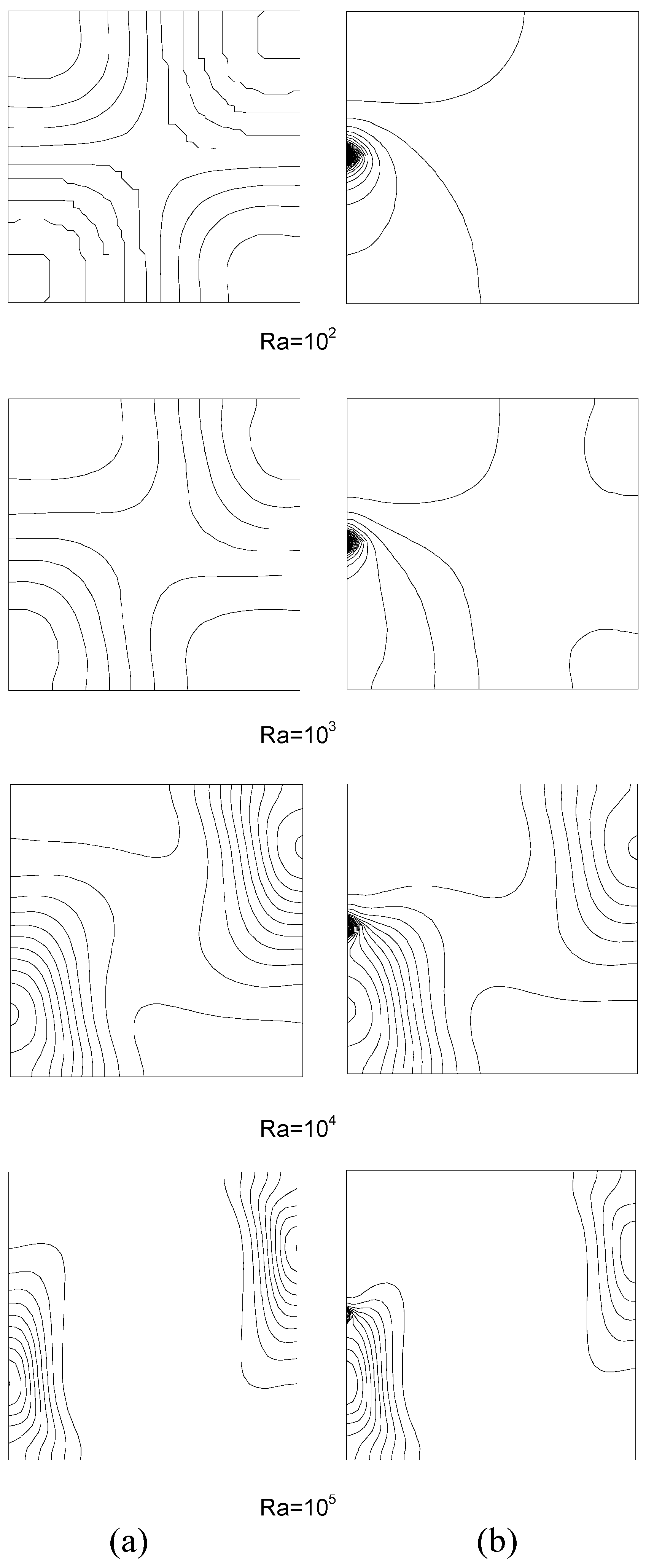
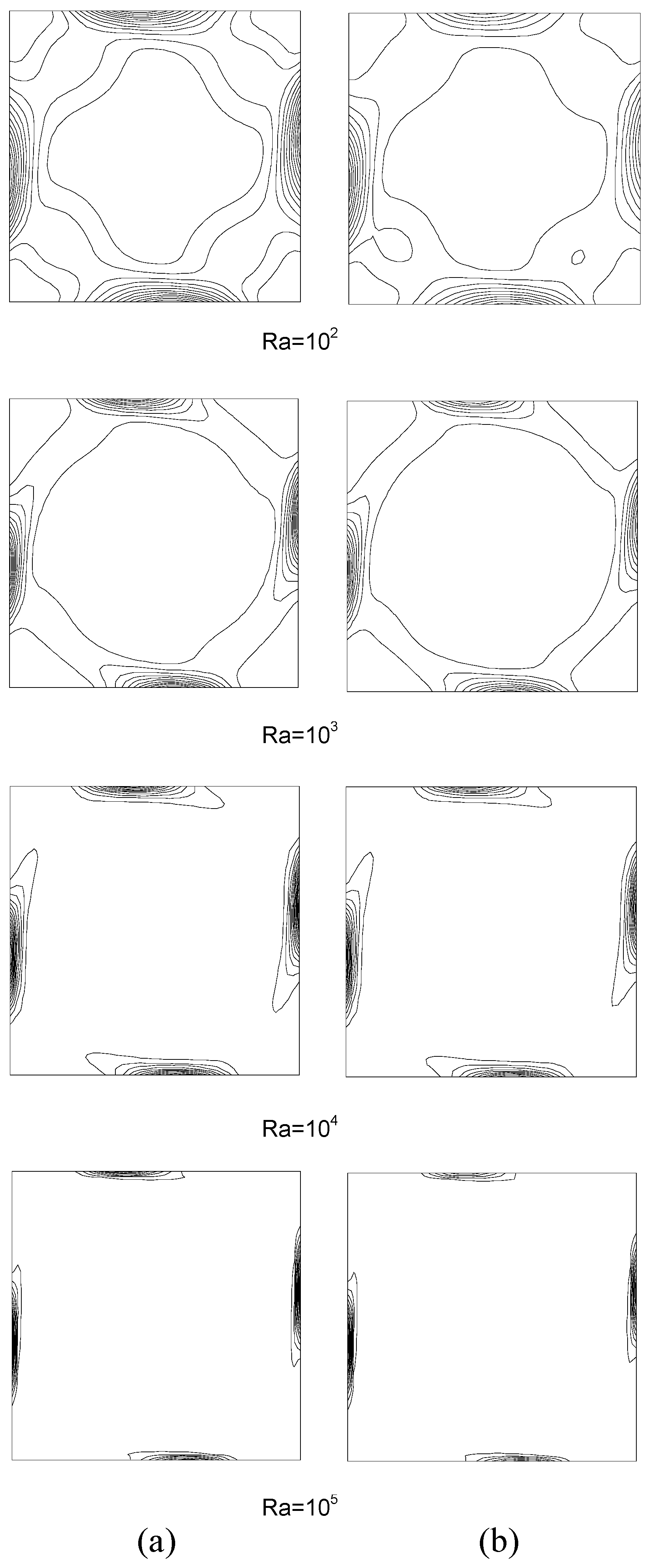
| Pr | Ra | Benchmark values by Lage and Bejan [11] | Grid | Present values at steady-state |
| 0.01 | 102 | 1.00 | 40 x 40 | 1.004 |
| 103 | 1.05 | 40 x 40 | 1.080 | |
| 104 | 1.50 | 40 x 40 | 1.593 | |
| 105 | 2.77 | 70 x 70 | 2.778 | |
| 1.0 | 105 | 4.9 | 90 x 90 | 4.674 |
| 106 | 9.2 | 100 x 100 | 9.194 | |
| 107 | 17.9 | 100 x 100 | 17.897 | |
| 108 | 31.8 | 200 x 200 | 31.784 |
© 2003 by MDPI. (http://www.mdpi.org) Reproduction for noncommercial purposes permitted.
Share and Cite
Erbay, L.B.; Altaç, Z.; Sülüs, B. An Analysis of The Entropy Generation in a Square Enclosure. Entropy 2003, 5, 496-505. https://doi.org/10.3390/e5050496
Erbay LB, Altaç Z, Sülüs B. An Analysis of The Entropy Generation in a Square Enclosure. Entropy. 2003; 5(5):496-505. https://doi.org/10.3390/e5050496
Chicago/Turabian StyleErbay, Latife Berrin, Zekeriya Altaç, and Birsen Sülüs. 2003. "An Analysis of The Entropy Generation in a Square Enclosure" Entropy 5, no. 5: 496-505. https://doi.org/10.3390/e5050496
APA StyleErbay, L. B., Altaç, Z., & Sülüs, B. (2003). An Analysis of The Entropy Generation in a Square Enclosure. Entropy, 5(5), 496-505. https://doi.org/10.3390/e5050496




